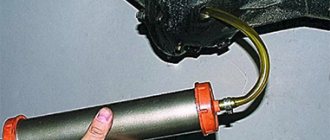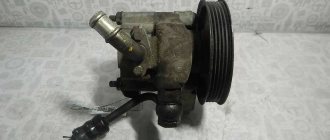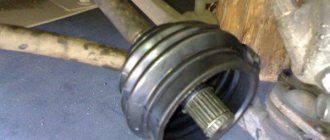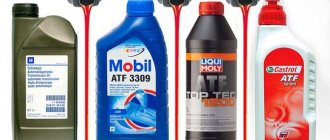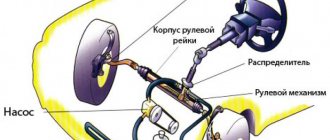Sometimes in the official vehicle operating instructions you can read such a clause that the power steering fluid is designed for the entire service life of the car and does not need to be changed.
Only in case of an accident or repair of steering components. And nothing is said at all about the maintenance of the hydraulic component of the steering. And many drivers drive, as they say, until victory.
Until the power steering pump hums or the steering rack seals leak. And, as a rule, not much time passes before the first serious malfunctions appear. Often, power steering problems persistently make themselves known even before the six-digit mileage is reached.
In this article, we will analyze the intricacies of the operation of a steering system equipped with power steering, and also provide a brief overview of power steering fluids and the features of their replacement.
What is power steering fluid
Power steering fluid is a specialized fluid that acts as a working fluid in the hydraulic power steering systems of cars, tractors and other wheeled vehicles.
Modern cars and trucks, buses, tractors and other wheeled vehicles are equipped with a system that facilitates the driver’s work - hydraulic power steering (power steering). This system consists of a liquid pump driven by the engine crankshaft, a power actuator, a control mechanism and piping. The actuator is racks or steering mechanisms with bipods, and the control mechanism is a distributor integrated with the rack or steering mechanism, which controls fluid flows depending on the direction and angle of rotation of the steering wheel.
Power steering uses various fluids as a working fluid, which are assigned several important functions:
- Transfer of force from the power steering pump to the actuator, which ensures the rotation of the steered wheels;
- Lubrication of rubbing parts of the power steering system;
- Protection of metal elements of power steering from corrosion;
- Cooling of the rubbing parts of the power steering system.
All these functions can be most effectively performed only by special fluids designed for use in power steering. These liquids have a number of features and distinctive features, which should be discussed in more detail.
How to check the fluid level?
Checking the condition of the oil in the power steering does not take much time. To do this, perform the following steps:
1. Unscrew the tank cap. Located near the power steering pump. This is a plastic, less often a metal tank.
2. Check the fluid level. Most reservoirs are made of translucent plastic, which allows you to quickly determine the amount of oil. To check the liquid level in metal tanks, you will have to use the dipstick, which is built into the lid.
3. Lower the dipstick into the tank, and then wipe it on a light cloth or napkin. The remaining traces will allow you to quickly determine the condition of the oil. A good liquid should have a transparent color and a uniform structure without cloudiness, traces of rust or metallic inclusions.
An unpleasant burning smell also indicates the need for replacement.
Classification of power steering hydraulic fluids
Fluids used in power steering can be divided according to several criteria:
- Color;
- Compound;
- Variety.
Color classification
It is wrong to be guided only by color gradation when choosing oil, although this practice is widespread among car owners. It is also often indicated what color liquids can be mixed and which ones should not be mixed.
Mixing is contraindicated with liquids based on composition and not color, and since now both mineral water and synthetics can be presented in any color, you should treat this information very carefully.
Red ATF gear oil is usually synthetic, the Dexron brand from General Motors is considered the standard, but there are products from other manufacturers, such as Revenol, Motul, Shell, Zic, etc.
Yellow oil, produced by the Daimler concern and under its license, is used in Mercedes-Benz hydraulic boosters. It can be synthetic and mineral.
Green oil. For the most part, multifunctional and universal liquids can be either synthetic or mineral in composition. They are used in power steering, suspension and other systems that operate on liquids. It cannot be mixed with other colors, except in cases where the manufacturer declares full compatibility, for example Comma PSF MVCHF is compatible with some types of Dexron.
Reds
They belong to the ATF class, that is, transmission. Most often used for automatic transmissions, but sometimes also used for power steering. The red brands Dexron II and Dexron III are developed by the automobile concern General Motors. There are other red brands, but they are manufactured under license from General Motors.
Yellow
This liquid is considered universal. This type of oil can be found in most hydraulic power steering systems. This lubricant is also used in manual and automatic transmissions.
Green
Synthetic or mineral based oil. For use exclusively in manual transmissions. You can use such a lubricant in power steering, but before doing this you need to drain all the old fluid and flush the system.
Types of power steering fluids
Power steering fluids must have different properties, which are provided by additives and chemical composition. Among them:
- required viscosity index;
- temperature resistance;
- mechanical and hydraulic properties;
- corrosion protection;
- anti-foam properties;
- lubricating properties.
All power steering fluids on the market have all these characteristics to one degree or another.
In turn, according to their chemical composition they are distinguished:
- synthetic;
- semi-synthetic;
- mineral oils.
Let's look at their differences and scope of application.
Synthetic
Synthetics are based on hydrocarbons (alkylbenzenes, polyalphaolefins) and various esters. All these compounds are obtained as a result of directed chemical synthesis from oil. This is a base to which various additives are added. Synthetic oils have the following advantages:
- high viscosity index;
- thermal-oxidative stability;
- long service life;
- low volatility;
- resistance to low and high temperatures;
- Excellent anti-corrosion, anti-foam and lubricating properties.
But even with such characteristics, fully synthetic oils are rarely used in power steering systems due to the many rubber seals that are aggressively affected by synthetics. Synthetics are used only if approved by the manufacturer. Another disadvantage of synthetics is the high price.
Semi-synthetic
To neutralize the aggressive effect on rubber parts, manufacturers add a variety of silicone additives.
Mineral
Mineral oils are based on various petroleum fractions, such as naphthenes and paraffins. 97% is a mineral base, the other 3% is additives. Such oils are more suitable for power steering, as they are neutral to rubber elements. Operating temperature ranges from -40°C to 90°C. Synthetics work up to 130°C-150°C, the lower limit is similar. Mineral oils are affordable, but in other respects they are inferior to synthetic ones. This concerns service life, foaming and lubricity.
What kind of oil should be poured into the power steering - synthetic or mineral? First of all, the one recommended by the manufacturer.
Differences between hydraulic fluids
Dexron. Lubricants have been produced since 1968. This is a separate class created by General Motors Corporation. Dexron is an official brand and is not manufactured exclusively by GM.
ATF (Automatic Transmission Fluid) - lubricants intended for automatic transmissions. Widespread among Japanese manufacturers. Often such hydraulic oil is found in power steering, most of it has a red tint.
PSF (Power Steering Fluid) – oil for hydraulic booster.
Multi HF are universal hydraulic oils for use in hydraulic power steering systems, allow complete mixing and interchangeability, and have approvals from many automakers. This oil is the best choice when purchasing.
Changing power steering oil - description of the process
Replacing the lubricant in the power steering is a rather painstaking task; you should take the procedure seriously and follow the instructions.
Adding fluid
To add oil, it is recommended to purchase Multi HF universal fluid, since it can be mixed with absolutely any lubricant.
Instructions for adding hydraulic lubricant to the power steering:
- Inspect the power steering reservoir and mechanism for leaks. If there are any, they need to be eliminated;
- Check the hydraulic oil level in the power steering reservoir;
- After removing the plug, add fluid to about;
- Start the engine and turn the steering wheel from the extreme left to the extreme right;
- Check the lubricant level in the power steering reservoir and, if necessary, top up to about.
Complete fluid change
A complete lubricant change requires great perseverance and coordination. Hydraulic oil must be selected based on the manufacturer’s recommendations.
- Hang up the car. This is done to facilitate rotation of the steering wheel when the engine is off;
- We will need a syringe - we need to pump out all the fluid from the power steering reservoir;
- Then loosen the clamps on the hoses, remove them from the tank, rinse the container itself thoroughly;
- Direct the return line (steering rack hose) into an empty jar - the liquid remaining in the rack will drain there;
- By turning the steering wheel, remove any remaining lubricant from the mechanism. It is required to make quite intense and prolonged movements with the steering wheel;
- After the hydraulic oil stops leaking, you need to fill (rinse) the rack with freshly purchased fluid. To do this, insert a funnel into the second hose and fill it to capacity;
- After this, we repeat the manipulations with the steering wheel again. When all the oil has flowed out of the return hose, the procedure can be completed;
- Then reassemble the hydraulic power steering system in reverse order;
- Fill the mechanism reservoir with oil according to the level;
- After the system is filled, you need to turn the steering wheel from the extreme left position to the extreme right. Such manipulations should be carried out with the engine running;
- We turn off the engine, lower the car, check the tightness of the connections, and add fluid to the amplifier tank to the maximum.
This is interesting: How to replace the driveshaft crosspiece with a gazelle?
Belt Drive Power Steering Pump
Terms of use of liquids
It is also worth taking care of how to change the oil in the hydraulic booster. Such information is always contained in the car’s service book. No less often, manufacturers recommend not changing this oil at all. They are guided by a simple rule: the service life of the mixture is designed for the average life of the machine.
But a car can serve faithfully for quite a long time. If the fluid is not original, it needs to be changed more often. Some manufacturers clearly prescribe the procedure for replacing the fluid, including taking into account cases when the composition is not original. Often the control period ranges from 50 to 100 thousand kilometers.
If there is a problem with the power steering system, the first thing you need to do is change the oil. It is also worth checking the condition of the fluid in the power steering. If it has darkened, thickened, or smells unpleasant, it needs to be changed. By the way, synthetic compounds can be used much longer.
Difficulty with self-replacement
To avoid difficulties when changing the lubricant yourself, the consumer must:
- accurately identify the condition, as well as the volume of the substance poured into the power steering;
- determine the type of substance poured into the tank;
- it is important to completely pump out the entire volume of consumables so that the new oil does not mix with the used oil;
- Perform fluid pumping through the power steering system while the vehicle is stationary.
Consequences of using low-quality lubricant
If a low-quality lubricant is added to the power steering, this can cause the following consequences:
- The liquid will lose its parameters when operating at elevated temperatures. During operation, the temperature of the lubricant can be increased to 100 degrees. If the lubricant base consists of low-quality additives, the liquid will coagulate, and as a result, the procedure for turning the steering wheel may cause difficulties. Excessively low-quality oils lead to breakdown of power steering mechanisms, in particular the pumping device.
- When using low-quality lubricant, vapors hazardous to human health can be released, which, when the temperature of the liquid increases, enters the vehicle interior through the ventilation system.
- Rapid wear of power steering components may occur. Low-quality lubricants lead to the destruction of oil seals and sealing components of the power steering. As a result, substance leakage may occur.
Is it possible to fill the power steering with engine oil?
Motor - definitely not, transmission - with reservations. Next we will look in detail why.
To understand whether other oils, such as motor or transmission oils, can be poured into the power steering, you need to know what functions it performs.
The power steering fluid must cope with the following tasks:
- Lubrication of all power steering components;
- Protection against corrosion and wear of parts;
- Pressure transfer;
- Prevents foaming;
- System cooling.
The above characteristics are achieved by adding various additives, the presence and combination of which gives power steering oil the necessary qualities.
As you understand, the tasks of motor oil are somewhat different, so it is highly not recommended to pour it into the power steering.
Regarding transmission oil, everything is not so clear; the Japanese often use the same ATF fluid for automatic transmission and power steering. Europeans insist on using special PSF (Power Steering Fluid) oils.
Replacing antifreeze
It is better to add antifreeze once every two years. But you can find out more precisely about the frequency of replacement from the car manufacturer’s instructions.
Which antifreeze to choose? There are many manufacturers on the market, each of them has a large selection of options with various additives (green antifreeze differs from red antifreeze not only in color, but also in properties).
We recommend Sakura antifreeze. Its advantages:
- suitable for use in harsh climatic conditions;
- the presence of more than 10 effective additives in the composition;
- removes heat well;
- does not lose effectiveness within 3-5 years of use.
Ravenol antifreeze may also be a good option. Combination of low price and good efficiency.
Choosing low-quality antifreeze will lead to engine overheating and rapid wear of parts, so it is better not to skimp on it.


